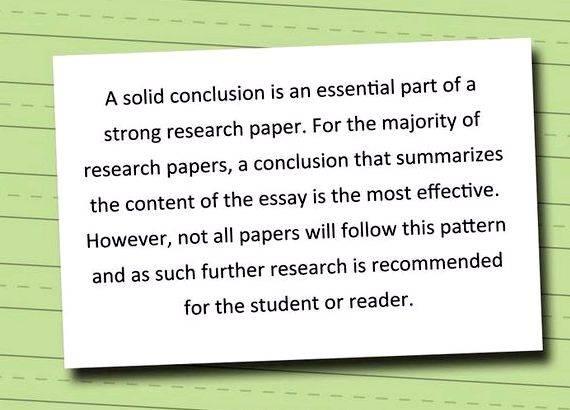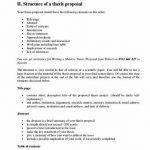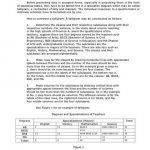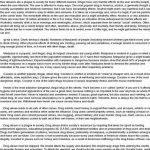This page is brought to you by the OWL at Purdue (https://owl.english.purdue.edu/). When printing this page, you must include the entire legal notice at bottom.
This resource was written by Jaclyn M. Wells .
Last edited by Allen Brizee on March 22, 2013 .
This resource covers writing a detailed conclusion for your GED essay.
Writing a Developed and Detailed Conclusion
It is important to have a strong conclusion, since this is the last chance you have to make an impression on your reader. The goal of your conclusion isn’t to introduce any new ideas, but to sum up everything you’ve written. Specifically, your conclusion should accomplish three major goals:
- Restate the main idea of your essay, or your thesis statement
- Summarize the three subpoints of your essay
- Leave the reader with an interesting final impression
The paragraph below is an example conclusion. As you read, think about what each sentence accomplishes within the paragraph. What sentence(s) restates the essay’s thesis statement? What sentence(s) summarizes the essay’s three subpoints? What sentence(s) leaves the reader with an interesting final impression?
Getting a better job is a goal that I would really like to accomplish in the next few years. Finishing school will take me a long way to meeting this goal. To meet my goal, I will also prepare my résumé and search for jobs. My goal may not be an easy one to achieve, but things that are worth doing are often not easy.
Notice that the first sentence restates the thesis. The second and third sentences summarize the essay’s subpoints. Finally, the fourth sentence leaves the reader with an interesting final impression.
No new information is presented in this paragraph. Instead, the writer sums up what has been written so far and leaves the reader with a last thought. While the content of the paragraph is very similar to the introduction, the paragraph itself is not exactly the same. This is important. Even though the goal of the conclusion is to restate a lot of the information from the introduction, it should sound different because the conclusion’s purpose is slightly different from the introduction.
Practice writing a conclusion using the sample essay topic and the thesis statement. Remember to support the points you have gathered. Remember to restate your thesis, summarize your subpoints, and leave the reader with an interesting final impression.
For more information development and details, please visit these Purdue OWL resources:
To practice responding to a writing prompt, please use the CWEST GED Essay Game .
The Writing Lab OWL at Purdue University care about accessiblity and content quality. Contact Dana Driscoll to share your comments and concerns. The OWL at Purdue now conforms to W3C.org -validated XHTML 1.0 Strict and CSS 2.0 standards. Additionally, the site passes the Cynthia Says test for ADA Section 508 compliance.
1995-2016 by The Writing Lab The OWL at Purdue and Purdue University. All rights reserved. This material may not be published, reproduced, broadcast, rewritten, or redistributed without permission. Use of this site constitutes acceptance of our terms and conditions of fair use .

Though expectations vary from one discipline to the next, the conclusion of your paper is generally a place to explore the implications of your topic or argument. In other words, the end of your paper is a place to look outward or ahead in order to explain why you made the points you did.
Writing the Conclusion
In the past, you may have been told that your conclusion should summarize what you have already said by restating your thesis and main points. It is often helpful to restate your argument in the conclusion, particularly in a longer paper, but most professors and instructors want students to go beyond simply repeating what they have already said. Restating your thesis is just a short first part of your conclusion. Make sure that you are not simply repeating yourself; your restated thesis should use new and interesting language.
After you have restated your thesis, you should not just summarize the key points of your argument. Your conclusion should offer the reader something new to think about–or, at the very least, it should offer the reader a new way of thinking about what you have said in your paper.
You can employ one of several strategies for taking your conclusion that important step further:
- Answer the question, “So what?”
- Connect to a larger theme from the course
- Complicate your claim with an outside source
- Pose a new research question as a result of your paper’s findings
- Address the limitations of your argument
The strategy you employ in writing a conclusion for your paper may depend upon a number of factors:
- The conventions of the discipline in which you are writing
- The tone of your paper (whether your paper is analytical, argumentative, explanatory, etc.)
- Whether your paper is meant to be formal or informal
Choose a strategy that best maintains the flow and tone of your paper while allowing you to adequately tie together all aspects of your paper.
The Final “So what?” Strategy
Part of generating a thesis statement sometimes requires answering the “so what?” question–that is, explaining the significance of your basic assertion. When you use the “so what?” strategy to write your conclusion, you are considering what some of the implications of your argument might be beyond the points already made in your paper. This strategy allows you to leave readers with an understanding of why your argument is important in a broader context or how it can apply to a larger concept.
For example, consider a paper about alcohol abuse in universities. If the paper argues that alcohol abuse among students depends more on psychological factors than simply the availability of alcohol on campus, a “so what?” conclusion might tie together threads from the body of the paper to suggest that universities are not approaching alcohol education from the most effective perspective when they focus exclusively on limiting students’ access to alcohol.
To use this strategy, ask yourself, “How does my argument affect how I approach the text or issue?”
The “Connecting to a Course Theme” Strategy
When you use the “connecting to a course theme” strategy to write your conclusion, you are establishing a connection between your paper’s thesis and a larger theme or idea from the course for which you are writing your paper.
For example, consider a paper about mothers and daughters in Eudora Welty’s Delta Wedding for a class called “The Inescapable South.” This paper argues that a strong dependence on the mother is analogous to a strong dependence on the South. A “connecting to a course theme” conclusion for this paper might propose that Welty’s daughter characters demonstrate what type of people can and cannot escape the South.
To use this strategy, ask yourself, “What is an overall theme of this course? How does my paper’s thesis connect?”
The “Complicating Your Claim” Strategy
When you use the “complicating your claim” strategy to write your conclusion, you are using one or more additional resources to develop a more nuanced final thesis. Such additional resources could include a new outside source or textual evidence that seemingly contradicts your argument.
For example, consider a paper about Ireland’s neutrality during World War II. This paper argues that Ireland refused to enter the war because it wanted to assert its sovereignty, not because it had no opinion about the conflict. A “complicating your claim” conclusion for this paper might provide historical evidence that Ireland did aid the Allies, suggesting that the Irish were more influenced by international diplomacy than their formal neutrality might suggest.
To use this strategy, ask yourself, “Is there any evidence against my thesis?” or “What does an outside source have to say about my thesis?”
The “Posing a New Question” Strategy
When you use the “posing a new question” strategy to write your conclusion, you are inviting the reader to consider a new idea or question that has appeared as a result of your argument.
For example, consider a paper about three versions of the folktale “Rapunzel.” This paper argues that German, Italian, and Filipino versions of “Rapunzel” all vary in terms of characterization, plot development, and moral, and as a result have different themes. A “posing a new question” conclusion for this paper might ask the historical and cultural reasons for how three separate cultures developed such similar stories with such different themes.
To use this strategy, ask yourself, “What new question has developed out of my argument?”
The “Addressing Limitations” Strategy
When you use the “addressing limitations” strategy to write your conclusion, you are discussing the possible weaknesses of your argument and, thus, the fallibility of your overall conclusion. This strategy is often useful in concluding papers on scientific studies and experiments.
For example, consider a paper about an apparent correlation between religious belief and support for terrorism. An “addressing limitations” conclusion for this paper might suggest that the apparent correlation relies on the paper’s definition of “terrorism” and, since the definition is not objective, the apparent correlation might have been wrongly identified.
To use this strategy, ask yourself, “In what aspects is my argument lacking? Are there circumstances in which my conclusions might be wrong?”
Polishing Your Conclusion–and Your Paper
After you’ve completed your conclusion, look over what you have written and consider making some small changes to promote clarity and originality:
- Unless your discipline requires them, remove obvious transitions like “in conclusion,” “in summary,” and “in result” from your conclusion; they get in the way of the actual substance of your conclusion.
- Consider taking a strong phrase from your conclusion and using it as the title or subtitle of your paper.
Also, be sure to proofread your conclusion carefully for errors and typos. You should double-check your entire paper for accuracy and correct spelling as well.
Produced by Writing Tutorial Services, Indiana University, Bloomington, IN
wts/shtml_navs/iub.jpg” />
Writing Tutorial Services
Center for Innovative Teaching and Learning
Wells Library Learning Commons, 1320 E. Tenth St. Bloomington, IN 47405
Phone: (812) 855-6738
Comments






 Maxime descoteaux phd thesis writing
Maxime descoteaux phd thesis writing Correct spelling master thesis proposal
Correct spelling master thesis proposal Textual presentation in thesis proposal
Textual presentation in thesis proposal Kahalagahan ng pag aaral thesis writing
Kahalagahan ng pag aaral thesis writing Elie wiesel the perils of indifference thesis proposal
Elie wiesel the perils of indifference thesis proposal






